The Samsung Galaxy S21 Ultra & S21 Review: The Near Perfect and The Different
by Andrei Frumusanu on February 22, 2021 12:00 PM EST- Posted in
- Smartphones
- Samsung
- Mobile
- Galaxy S21
- Galaxy S21 Ultra
Display Measurement
We’ve noted many times now that the displays of the S21 series are relatively special, although for different reasons depending on the model.
The S21 Ultra’s new panel uses a new hybrid oxide pack panel technology along with a new OLED emitter generation that allows it offer seamless fine-grained refresh rate switching along with getting extremely bright while being much more power efficient. The smaller S21 doesn’t have any of the new display technologies, it is lower resolution, but still has software based adaptive frequency features. I did note that at least in terms of hardware build quality, the smaller S21 does seem to have advantages over the S20 series when it comes to its lamination, as I am seeing better viewing angles, and the panel being better glued to the glass.
When it comes to colour accuracy, we find Samsung’s usual display modes, limited to a “Vivid” setting that’s more saturated in terms of the colours, and allows you to fine-tune colour temperature to your taste, and the “Natural” screen mode that tries to adhere to sRGB and Display P3 colour gamuts and features near 6500K whites.
We move on to the display calibration and fundamental display measurements of the Galaxy S21 Ultra and S21 screens. As always, we thank X-Rite and SpecraCal, as our measurements are performed with an X-Rite i1Pro 2 spectrophotometer, with the exception of black levels which are measured with an i1Display Pro colorimeter. Data is collected and examined using Portrait Display's CalMAN software.

When it comes to screen brightness, the Galaxy S21 isn’t all much different to the S20 series, although it does allow for brighter manual brightness up to 393 nits on our unit. Peak full screen whites are still at around 700 nits when in auto-brightness mode under bright ambient conditions.
The S21 Ultra’s brightness is beyond any other OLED display on the market right now. Manual brightness is still limited by Samsung to only 462 nits, however when in auto-brightness, it goes to a staggering 942 nits – almost beating the superbly bright RGBW LCD display of the LG G7.
If you’re looking for a device which does excellently under sunlight, then the S21 Ultra is definitely the right choice.
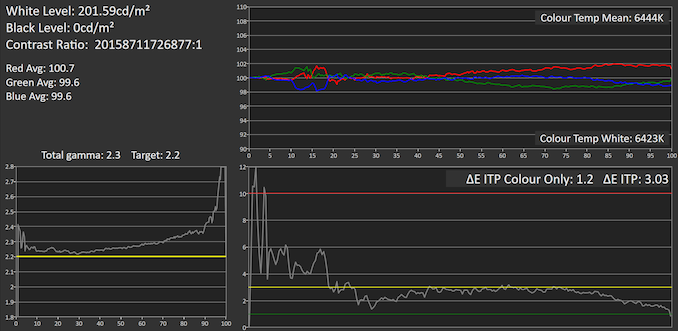
 Portrait Displays CalMAN
Portrait Displays CalMAN
Galaxy S21 Ultra
In terms of greyscale accuracy, the good news for this generation is that it seems Samsung has done a better job than in past years. Whites fall in at 6423K on the S21 Ultra, much less red than the S20 series devices’ calibration, with general great colour balance at dEITP of only 1.2. Gamma curve also looks reasonable although it’s still hard to measure this accurately due to Samsung’s APL brightness adjustments, even with fixed 50 APL and 50% windows sizes during out measurements.
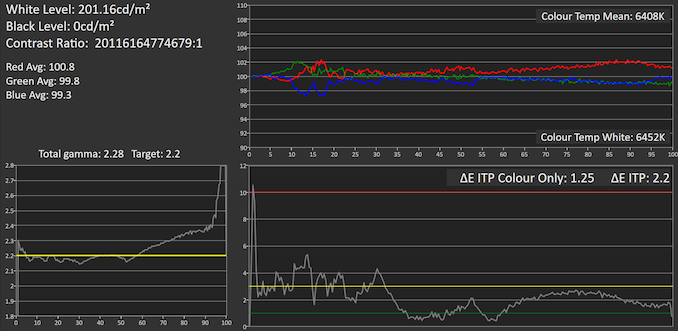
 Portrait Displays CalMAN
Portrait Displays CalMAN
Galaxy S21
The smaller Galaxy S21 also does very well, with great colour temperature out of the box .
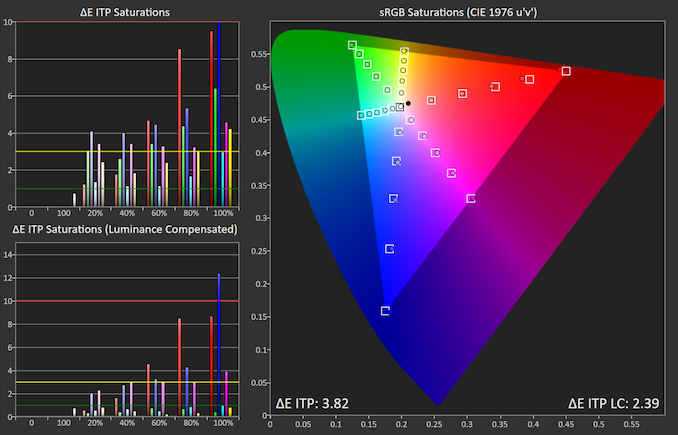 Portrait Displays CalMAN
Portrait Displays CalMAN
Galaxy S21 Ultra
Saturation accuracy on the S21 Ultra is great in all aspects except the reds, which for some reason are undersaturated at the maximum intensities.
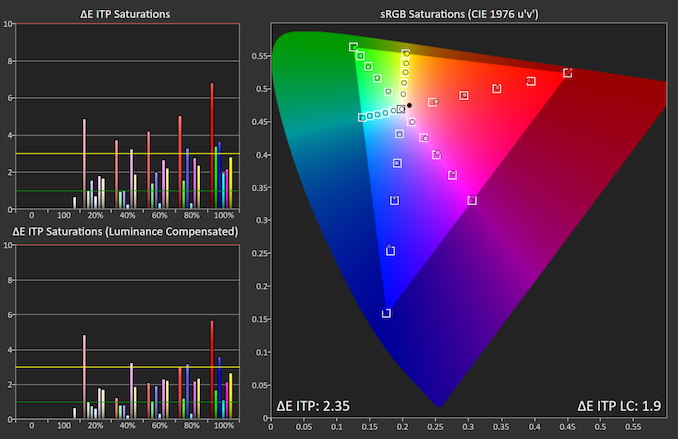 Portrait Displays CalMAN
Portrait Displays CalMAN
Galaxy S21
The smaller S21 doesn’t have the same issue, showcasing generally more accurate colours.

 Portrait Displays CalMAN
Portrait Displays CalMAN
Galaxy S21 Ultra
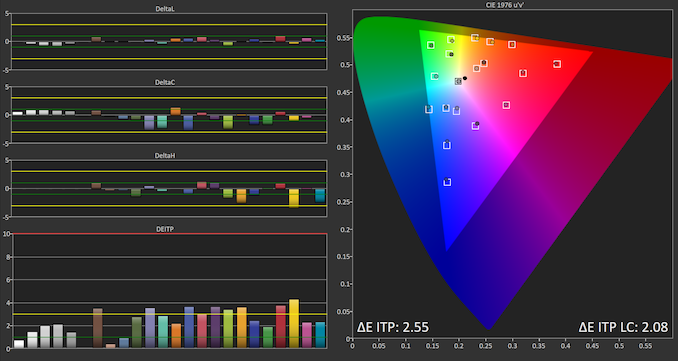
 Portrait Displays CalMAN
Portrait Displays CalMAN
Galaxy S21
Gretag MacBeth test patches with common colours such as skin tones fare well for both the S21 Ultra as well as the S21, although the latter does better, showcasing less luminosity errors.
Overall, Samsung did uncharacteristically well this year when it comes to colour accuracy. After a few years of glaring gamma issues and too warm whites, the S21 series seems to be able to achieve great results out of the box, early on in its firmware, which couldn’t be said of the S10 or S20 series.
The S21 Ultra’s display in terms of its fundamentals is outstanding – it gets extremely bright, more than any other phone in the market right now. Together with the 1440p resolution and 120Hz refresh rate, it represents the single best mobile display in the industry right now.
The smaller S21 display is good, although really not in the same class as the Ultra’s panel. There’s really nothing much to write home about here, as it’s very much similar to many other 1080p panels in the industry, with good brightness levels, good colour accuracy, and of course also featuring that 120Hz adaptive refresh rate mode. If the Ultra’s panel is an S-tier display, the baseline model’s display is A-tier.


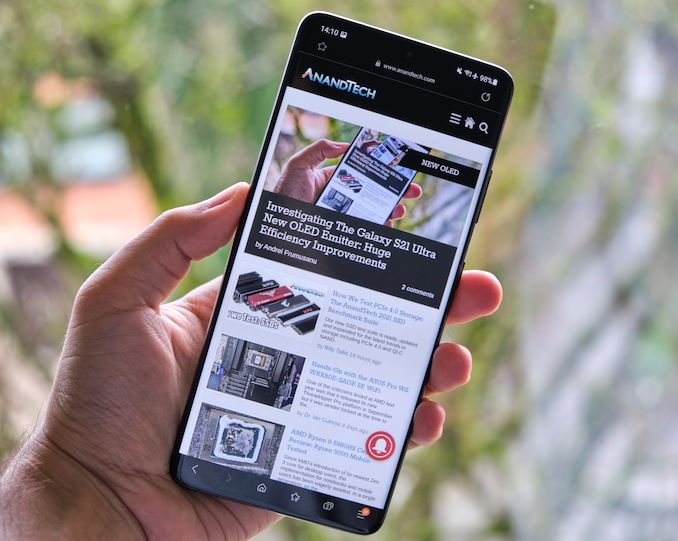








122 Comments
View All Comments
trajan - Wednesday, February 24, 2021 - link
Any thoughts on existing or upcoming phones the size of the base S21, but with flagship specs?As someone who strongly prefers the smaller size of the S21, I'm annoyed that I need to compromise on this generation of phones. Either I get top specs but have to deal with the larger size that I don't like, or I have to go smaller and take a real hit. I've tried holding phones the size of the S21+/Ultra and its just not comfortable. I guess I have small hands (oh no).
flyingpants265 - Friday, February 26, 2021 - link
Yeah exactly, oh no. All the phones on the market are crap, but you're complaining that your hands are too small..Edwardmcardle - Friday, February 26, 2021 - link
Is there any noticable difference in radio reception between snapdragon and exynos? I had the exynos version and both wifi and 4g were worse compared to my 7 pro side by side.darkich - Saturday, February 27, 2021 - link
Extremely well done camera comparison. Amazing work.Are those flares on HDR section normal? Looks like you forgot to clean the lenses.
This little detail(cleaning the camera lens) can make a really major difference.
Andrei Frumusanu - Wednesday, March 3, 2021 - link
They are cleaned, those are just results of the camera optics.Steven Choi 4321 - Tuesday, March 2, 2021 - link
Again, it is not the hardware. It is about the operating system. Android is 100 times hard to learn for the normal public like me.Rude Russy - Tuesday, March 9, 2021 - link
What are you talking about? its as simple as IOS. I guess you just must be really stupid?redchar - Tuesday, March 2, 2021 - link
Great review, as always!Though I got to say, regardless of review quality, the galaxy S phones just aren't good anymore.
It's sad, they used to be the go-to phones, but between samsung removing hardware/firmware abilities and google doing the same for android, phones really plateaued. Haven't had a reason to have faster hardware in years since google's trying their hardest to prevent interesting software from even running that would need the speed. I'd say battery life would be interesting since the s21 and other phones have bigger batteries than previous gens, but android bloat keeps defeating advancements in batteries.
Shoutout to the xperia 1 ii though. at&t forced me to buy a new phone from a very small subset due to their whitelisting of VoLTE devices, and the xperia was the only one I saw which: Has a headphone jack, has an sd card, can be bootloader unlocked without having to reverse engineer anything, has various custom roms, doesnt ship with the SAF nightmare that is android 11, and is still a new phone covered by carriers. It's not quite as great as the oneplus 5 i had before, and costs quite a bit more, but if telcos are going to force upgrades, it's slim pickings for an actual flagship these days.
markiz - Monday, March 8, 2021 - link
"The flat display and the lower resolution do however feel very conventional, and not-quite flagship like."Ah, I see, so you are responsible for the plague :)
Edwardmcardle - Friday, April 9, 2021 - link
Did you notice any difference in other areas of the chip? WiFi, GSM / 4G, AI etc?